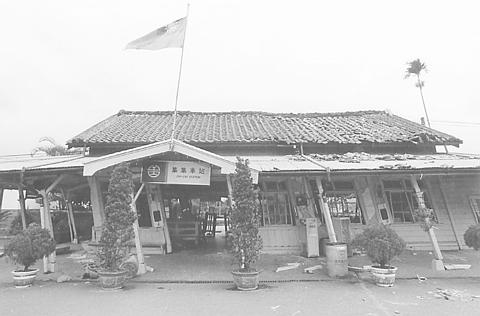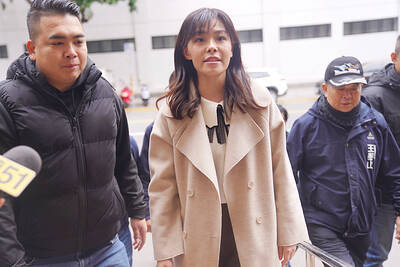The massive 921 earthquake not only claimed the lives of thou-sands of Taiwanese and their homes -- it left dozens of Taiwan's historic sites in ruins.
While an overall inspection of Taiwan's 388 national historic sites is being undertaken by the Ministry of Interior (MOI), some of the sites may unfortunately be gone forever because they were so severely damaged, according to the MOI's Civil Affairs director Chi Chun-chen (紀俊臣).
Among the damaged sites, the 200-year old Lin Family Gardens in Wufeng (

PHOTO: LU CHUN-WEI, LIBERTY TIMES
"Ninety percent of the wooden buildings were destroyed," Chi said, after checking the site with experts.
Ironically, according to Lin Cheng-chi (
The Lin family complex was owned by the wealthiest family in central Taiwan.
The complex, which covered 3,888 square meters, preserved many fine examples of Chinese-style architecture of the Ching dynasty. But the quake two weeks ago demolished nearly the whole area and claimed the lives of two members of the Lin clan.
"All that can be done now is to preserve the wooden relics and antiques left in the debris," Chi said. "We are still considering if we will rebuild the site or abolish it."
According to an initial estimate by the interior ministry, it could take more than NT$100 million to rebuild the complex.
Like the Lin mansion, the Lungshan Temple (龍山寺) in Lukan (鹿港), Chanhua County, was seriously damaged and will require NT$20 million to repair.
In Nantou County, three classical academies -- Mingshin (明新), Tengyen (登簷) and Lantien (藍田) -- were partly collapsed and will also require several millions of dollars for reconstruction, said Chi.
So far, the government has budgeted NT$250 million for emergency repair of damaged historic sites.
However, according to architect Yang Ren-chiang (
At the same time, both legislators and cultural heritage preservation groups urged the government take a closer look at other unregistered historical buildings.
DPP lawmaker Fan Shun-lu (
"As buildings with indicative red tape on them will be demolished within a week under the government's emergency decree, we are worried that those marked historic buildings will also be demolished," said Fan.
Among those buildings, the Chichi Railway Station (集集火車站) -- once a famous tourist spot -- was one of those dangerous buildings, according to Chiu Ru-hua (丘如華) of the Yaoshan Foundation (樂山文教基金會).
In response, Lin Cheng-chi has vowed to save the Chichi station from the wrecking ball.
"We will rebuild the station, and make it a symbol [of inspiration] to help the quake-stricken town stand up again," Lin said.
The Yaoshan Foundation has organized architectural scholars and students to form the League for 921 Reconstruction of Cultural Heritage.
So far, hundreds of professionals have gone to disaster sites for volunteer inspections.

The US government has signed defense cooperation agreements with Japan and the Philippines to boost the deterrence capabilities of countries in the first island chain, a report by the National Security Bureau (NSB) showed. The main countries on the first island chain include the two nations and Taiwan. The bureau is to present the report at a meeting of the legislature’s Foreign Affairs and National Defense Committee tomorrow. The US military has deployed Typhon missile systems to Japan’s Yamaguchi Prefecture and Zambales province in the Philippines during their joint military exercises. It has also installed NMESIS anti-ship systems in Japan’s Okinawa

‘WIN-WIN’: The Philippines, and central and eastern European countries are important potential drone cooperation partners, Minister of Foreign Affairs Lin Chia-lung said Minister of Foreign Affairs Lin Chia-lung (林佳龍) in an interview published yesterday confirmed that there are joint ventures between Taiwan and Poland in the drone industry. Lin made the remark in an exclusive interview with the Chinese-language Liberty Times (the Taipei Times’ sister paper). The government-backed Taiwan Excellence Drone International Business Opportunities Alliance and the Polish Chamber of Unmanned Systems on Wednesday last week signed a memorandum of understanding in Poland to develop a “non-China” supply chain for drones and work together on key technologies. Asked if Taiwan prioritized Poland among central and eastern European countries in drone collaboration, Lin

ON ALERT: Taiwan’s partners would issue warnings if China attempted to use Interpol to target Taiwanese, and the global body has mechanisms to prevent it, an official said China has stationed two to four people specializing in Taiwan affairs at its embassies in several democratic countries to monitor and harass Taiwanese, actions that the host nations would not tolerate, National Security Bureau (NSB) Director-General Tsai Ming-yen (蔡明彥) said yesterday. Tsai made the comments at a meeting of the legislature’s Foreign Affairs and National Defense Committee, which asked him and Minister of National Defense Wellington Koo (顧立雄) to report on potential conflicts in the Taiwan Strait and military preparedness. Democratic Progressive Party (DPP) Legislator Michelle Lin (林楚茵) expressed concern that Beijing has posted personnel from China’s Taiwan Affairs Office to its

BACK TO WORK? Prosecutors said they are considering filing an appeal, while the Hsinchu City Government said it has applied for Ann Kao’s reinstatement as mayor The High Court yesterday found suspended Hsinchu mayor Ann Kao (高虹安) not guilty of embezzling assistant fees, reducing her sentence to six months in prison commutable to a fine from seven years and four months. The verdict acquitted Kao of the corruption charge, but found her guilty of causing a public official to commit document forgery. The High Prosecutors’ Office said it is reviewing the ruling and considering whether to file an appeal. The Taipei District Court in July last year sentenced Kao to seven years and four months in prison, along with a four-year deprivation of civil rights, for contravening the Anti-Corruption